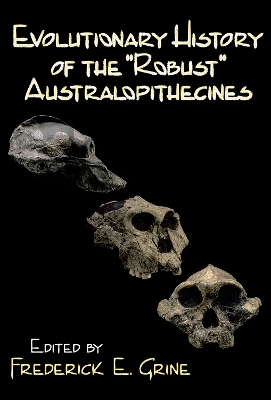
Evolutionary History of the Robust Australopithecines
AldineTransaction (Verlag)
978-0-202-36137-6 (ISBN)
In paleoanthropology the group of hominids known as the "robust" australopithecines has emerged as one of the most interesting. Through them we have the opportunity to examine the origin, natural history, and ultimate extinction of not just a single species, but of an entire branch in the hominid fossil record. It is generally agreed that the human lineage can be traced back to this group of comparatively small-brained, large-toothed creatures. This volume focuses on the evolutionary history of these early hominids with state-of-the-art contributions by leading international authorities in the field. Although a case can be made for a "robust" lineage, the functional and taxonomic implications of the morphological features are subject to vigorous disagreement. An area of lively debate is the possible causal relationship between the presence of early Homo and the origin, evolution, and virtual extinction of "robust" australopithecines.This volume summarizes what has been learned about the evolutionary history of the "robust" australopithecines in the 50 years since Robert Broom first encountered the visage of a new kind of ape-man from Kromdraai. New discoveries from Kromdraai to Lomekwi have served to keep us aware that the paleontological record for hominid evolution is hardly exhausted. Because of such finds no single volume can hope to stand as a summary on the "robust" australopithecines for very long, but this classic volume comes close to achieving this goal. The book sheds new light upon some old questions and also acts to provide new questions. The answers to those questions bring us closer to a fuller understanding and appreciation of the origins, evolution, and ultimate demise of the "robust" australopithecines. Since the "robust" australopithecines most likely stand as our closest relatives, a better understanding of their origin, history, and demise serves to provide heightened appreciation of the course of human evolution itself. This definitive volume addresses the questions and problems surrounding this important lineage.
Frederick E. Grine is professor and chairperson in the department of anthropology at the State University of New York at Stony Brook. He has published many scientific articles in books and international journals, and he is co-editor of Primate Phylogeny and Scanning Microscopy of Vertebrate Mineralized Tissues and author of Regional Human Anatomy.
Foreword,
Preface,
Acknowledgments,
List of Contributors, I. Studies of the Craniodental Evidence, 1. Enamel Thickness and Development in Australopithecus and Paranthropus, 2. Growth of Teeth and Development of the Dentition in Paranthropus, 3. Implications of In Vivo Experiments for Interpreting the Functional Significance of “Robust” Australopithecine Jaws, 4. Enlarged Occipital/Marginal Sinuses and Emissary Foramina: Their Significance in Hominid Evolution, 5. “Robust” Australopithecine Brain Endocasts: Some Preliminary Observations, 6. Growth Processes in the Cranial Base of Hominoids and Their Bearing on Morphological Similarities that Exist in the Cranial Base of Homo and Paranthropus, II. Studies of the Postcranial Evidence, 7. New Estimates of Body Size in Australopithecines, 8. Associated Cranial and Postcranial Bones of Australopithecus boisei, 9. New Estimates of Body Weight in Early Hominids and Their Significance to Encephalization and Megadontia in “Robust” Australopithecines, 10. New Postcranial Remains from Swartkrans and Their Bearing on the Functional Morphology and Behavior of Paranthropus robustus, III. Studies of Variation and Taxonomy, 11. Variation, Sexual Dimorphism and the Taxonomy of Australopithecus, 12. On Variation in the Masticatory System of Australopithecus boisei, 13. Evolution of the “ Robust” Australopithecines in the Omo Succession: Evidence from Mandibular Premolar Morphology, 14. New Craniodental Fossils of Paranthropus from the Swartkrans Formation and Their Significance in “ Robust” Australopithecine Evolution, IV. Studies of Evolutionary Relationships, 15 The Evolution of Australopithecus boisei, 16. Implications of KNM-WT 17000 for the Evolution of “Robust” Australopithecus, 17. Are “ Robust” Australopithecines a Monophyletic Group?, 18. A New Australopithecus Cranium from Sterkfontein and Its Bearing on the Ancestry of Paranthropus, 19. Numerous Apparently Synapomorphic Features in Australopithecus robustus, Australopithecus boisei and Homo habilis: Support for the Skelton-McHenry-Drawhorn Hypothesis, V. Studies of Paleogeography, Paleoecology and Natural History, 20. New Information from the Swartkrans Cave of Relevance to “Robust” Australopithecines, 21. Chronology of South African Australopith Site Units, 22. “Robust” Hominids and Plio-Pleistocene Paleogeography of the Turkana Basin, Kenya and Ethiopia, 23. Habitat Preference and Paleoecology of Australopithecus boisei in Eastern Africa, 24. The Deep-Sea Oxygen Isotope Record, The Global Ice Sheet System and Hominid Evolution, 25. Late Pliocene Climatic Events and Hominid Evolution, 26. Tooth Morphology, Wear and Diet in Australopithecus and Paranthropus from Southern Africa, 27. The Comparative Biology of “ Robust” Australopithecus: Clues from Context, 28. Divergence between Early Hominid Lineages: The Roles of Competition and Culture, 29. The Causes of “ Robust” Australopithecine Extinction, VI. Summary Comments, 30. Evolutionary History of the “Robust” Australopithecines: A Summary and Historical Perspective, Specimen Index, Subject Index
| Erscheint lt. Verlag | 22.4.2008 |
|---|---|
| Verlagsort | Somerset |
| Sprache | englisch |
| Maße | 178 x 254 mm |
| Gewicht | 975 g |
| Themenwelt | Naturwissenschaften ► Biologie ► Evolution |
| Naturwissenschaften ► Biologie ► Humanbiologie | |
| Sozialwissenschaften ► Ethnologie | |
| Sozialwissenschaften ► Soziologie | |
| ISBN-10 | 0-202-36137-3 / 0202361373 |
| ISBN-13 | 978-0-202-36137-6 / 9780202361376 |
| Zustand | Neuware |
| Haben Sie eine Frage zum Produkt? |
aus dem Bereich


